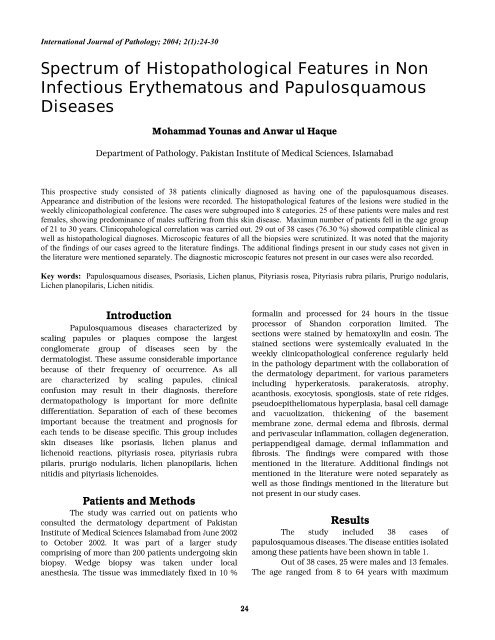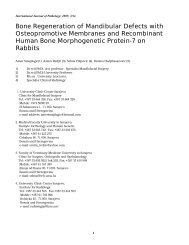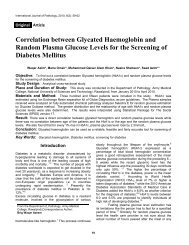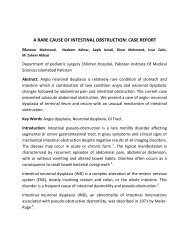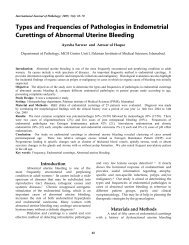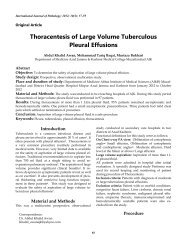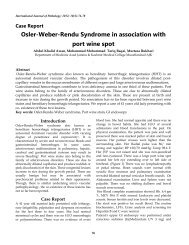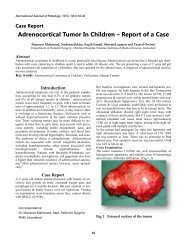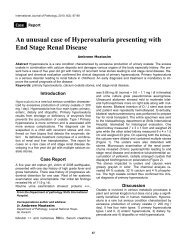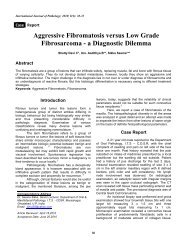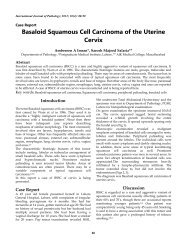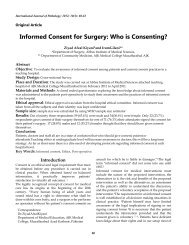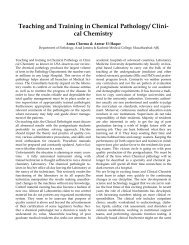Spectrum of Histopathological Features in Non Infectious ...
Spectrum of Histopathological Features in Non Infectious ...
Spectrum of Histopathological Features in Non Infectious ...
Create successful ePaper yourself
Turn your PDF publications into a flip-book with our unique Google optimized e-Paper software.
International Journal <strong>of</strong> Pathology; 2004; 2(1):24-30<br />
<strong>Spectrum</strong> <strong>of</strong> <strong>Histopathological</strong> <strong>Features</strong> <strong>in</strong> <strong>Non</strong><br />
<strong>Infectious</strong> Erythematous and Papulosquamous<br />
Diseases<br />
Mohammad Younas and Anwar ul Haque<br />
Department <strong>of</strong> Pathology, Pakistan Institute <strong>of</strong> Medical Sciences, Islamabad<br />
This prospective study consisted <strong>of</strong> 38 patients cl<strong>in</strong>ically diagnosed as hav<strong>in</strong>g one <strong>of</strong> the papulosquamous diseases.<br />
Appearance and distribution <strong>of</strong> the lesions were recorded. The histopathological features <strong>of</strong> the lesions were studied <strong>in</strong> the<br />
weekly cl<strong>in</strong>icopathological conference. The cases were subgrouped <strong>in</strong>to 8 categories. 25 <strong>of</strong> these patients were males and rest<br />
females, show<strong>in</strong>g predom<strong>in</strong>ance <strong>of</strong> males suffer<strong>in</strong>g from this sk<strong>in</strong> disease. Maximun number <strong>of</strong> patients fell <strong>in</strong> the age group<br />
<strong>of</strong> 21 to 30 years. Cl<strong>in</strong>icopahological correlation was carried out. 29 out <strong>of</strong> 38 cases (76.30 %) showed compatible cl<strong>in</strong>ical as<br />
well as histopathological diagnoses. Microscopic features <strong>of</strong> all the biopsies were scrut<strong>in</strong>ized. It was noted that the majority<br />
<strong>of</strong> the f<strong>in</strong>d<strong>in</strong>gs <strong>of</strong> our cases agreed to the literature f<strong>in</strong>d<strong>in</strong>gs. The additional f<strong>in</strong>d<strong>in</strong>gs present <strong>in</strong> our study cases not given <strong>in</strong><br />
the literature were mentioned separately. The diagnostic microscopic features not present <strong>in</strong> our cases were also recorded.<br />
Key words: Papulosquamous diseases, Psoriasis, Lichen planus, Pityriasis rosea, Pityriasis rubra pilaris, Prurigo nodularis,<br />
Lichen planopilaris, Lichen nitidis.<br />
Introduction<br />
Papulosquamous diseases characterized by<br />
scal<strong>in</strong>g papules or plaques compose the largest<br />
conglomerate group <strong>of</strong> diseases seen by the<br />
dermatologist. These assume considerable importance<br />
because <strong>of</strong> their frequency <strong>of</strong> occurrence. As all<br />
are characterized by scal<strong>in</strong>g papules, cl<strong>in</strong>ical<br />
confusion may result <strong>in</strong> their diagnosis, therefore<br />
dermatopathology is important for more def<strong>in</strong>ite<br />
differentiation. Separation <strong>of</strong> each <strong>of</strong> these becomes<br />
important because the treatment and prognosis for<br />
each tends to be disease specific. This group <strong>in</strong>cludes<br />
sk<strong>in</strong> diseases like psoriasis, lichen planus and<br />
lichenoid reactions, pityriasis rosea, pityriasis rubra<br />
pilaris, prurigo nodularis, lichen planopilaris, lichen<br />
nitidis and pityriasis lichenoides.<br />
Patients and Methods<br />
The study was carried out on patients who<br />
consulted the dermatology department <strong>of</strong> Pakistan<br />
Institute <strong>of</strong> Medical Sciences Islamabad from June 2002<br />
to October 2002. It was part <strong>of</strong> a larger study<br />
compris<strong>in</strong>g <strong>of</strong> more than 200 patients undergo<strong>in</strong>g sk<strong>in</strong><br />
biopsy. Wedge biopsy was taken under local<br />
anesthesia. The tissue was immediately fixed <strong>in</strong> 10 %<br />
24<br />
formal<strong>in</strong> and processed for 24 hours <strong>in</strong> the tissue<br />
processor <strong>of</strong> Shandon corporation limited. The<br />
sections were sta<strong>in</strong>ed by hematoxyl<strong>in</strong> and eos<strong>in</strong>. The<br />
sta<strong>in</strong>ed sections were systemically evaluated <strong>in</strong> the<br />
weekly cl<strong>in</strong>icopathological conference regularly held<br />
<strong>in</strong> the pathology department with the collaboration <strong>of</strong><br />
the dermatology department, for various parameters<br />
<strong>in</strong>clud<strong>in</strong>g hyperkeratosis, parakeratosis, atrophy,<br />
acanthosis, exocytosis, spongiosis, state <strong>of</strong> rete ridges,<br />
pseudoepitheliomatous hyperplasia, basal cell damage<br />
and vacuolization, thicken<strong>in</strong>g <strong>of</strong> the basement<br />
membrane zone, dermal edema and fibrosis, dermal<br />
and perivascular <strong>in</strong>flammation, collagen degeneration,<br />
periappendigeal damage, dermal <strong>in</strong>flammation and<br />
fibrosis. The f<strong>in</strong>d<strong>in</strong>gs were compared with those<br />
mentioned <strong>in</strong> the literature. Additional f<strong>in</strong>d<strong>in</strong>gs not<br />
mentioned <strong>in</strong> the literature were noted separately as<br />
well as those f<strong>in</strong>d<strong>in</strong>gs mentioned <strong>in</strong> the literature but<br />
not present <strong>in</strong> our study cases.<br />
Results<br />
The study <strong>in</strong>cluded 38 cases <strong>of</strong><br />
papulosquamous diseases. The disease entities isolated<br />
among these patients have been shown <strong>in</strong> table 1.<br />
Out <strong>of</strong> 38 cases, 25 were males and 13 females.<br />
The age ranged from 8 to 64 years with maximum
International Journal <strong>of</strong> Pathology; 2004; 2(1):24-30<br />
patients (11), fall<strong>in</strong>g <strong>in</strong> the age group <strong>of</strong> 21-30 years.<br />
Out <strong>of</strong> 38 cases, 29 (76.30 %) showed compatible<br />
cl<strong>in</strong>ical as well as histopathological diagnoses. Various<br />
disease entities studied are detailed below.<br />
Disease entitiy No <strong>of</strong> cases Percentage Males Females<br />
Psoriasis 14 36.8 11 3<br />
Lichen planus 12 31.5 8 4<br />
Pityriasis rosea 3 7.9 2 1<br />
Pityriasis rubra pilaris 2 5.3 1 1<br />
Prurigo nodularis 2 5.3 0 2<br />
Lichenoid reactions 2 5.3 1 1<br />
Lichen planopilaris 2 5.3 1 1<br />
Lichen nitidis 1 2.6 1 0<br />
Psoriasis: Gross features: Appearance and<br />
distribution was variable rang<strong>in</strong>g from well<br />
demarcated scaly papules, plaques and lichenified and<br />
hyper pigmented lesions over scalp, back, extensor<br />
surfaces <strong>of</strong> the limbs and dorsum <strong>of</strong> hands, to<br />
generalized erythroderma.<br />
Microscopic features <strong>in</strong>cluded moderate to marked<br />
acanthosis and hyperkeratosis, parakeratosis, regular<br />
elongation and clubb<strong>in</strong>g <strong>of</strong> rete ridges, absent granular<br />
layer, Munro micro abscesses and mild spongiosis <strong>in</strong><br />
the majority <strong>of</strong> the cases, while supra papillary<br />
th<strong>in</strong>n<strong>in</strong>g, exocytosis and telangiectatic vessels were<br />
present <strong>in</strong> more than half <strong>of</strong> the cases. Other features<br />
<strong>in</strong>clud<strong>in</strong>g Kogoj abscesses, attenuated granular layer<br />
and irregular elongation <strong>of</strong> rete ridges were seen <strong>in</strong><br />
less than 50 % <strong>of</strong> the cases. Moderate to marked hyper<br />
pigmentation, marked spongiosis and thickened<br />
basement membrane zone were present <strong>in</strong> 2 cases and<br />
basal layer damage was observed <strong>in</strong> 1 case.<br />
Dermal features <strong>in</strong>cluded slight to moderate<br />
perivascular chronic <strong>in</strong>flammation <strong>in</strong> the majority. The<br />
<strong>in</strong>filtrate also <strong>in</strong>cluded eos<strong>in</strong>ophils <strong>in</strong> 9 and<br />
neutrophils <strong>in</strong> one case. Perivascular edema,<br />
perifollicular fibrosis, pigmentary <strong>in</strong>cont<strong>in</strong>ence and<br />
thickened vessels and nerves were seen <strong>in</strong> around 50<br />
% cases. Upper dermal edema and <strong>in</strong>flammation were<br />
seen <strong>in</strong> a few cases (<strong>in</strong> one case, it consisted <strong>of</strong><br />
mononuclears, neutrophils and eos<strong>in</strong>ophils, <strong>in</strong> the 2nd<br />
it consisted <strong>of</strong> neutrophils and <strong>in</strong> the 3rd consisted <strong>of</strong><br />
mononuclear cell and eos<strong>in</strong>ophils).<br />
Unusual features <strong>in</strong>cluded marked spongiosis, l<strong>in</strong>ear<br />
Munro abscesses, focal acantholysis, broad globular<br />
thickened and confluent rete ridges, blood and fibr<strong>in</strong><br />
25<br />
<strong>in</strong> the corneal layer and perivascular plasma cells <strong>in</strong><br />
one case each.<br />
Lichen planus: Gross features varied from itchy<br />
raised flat topped to crusty erythematous and<br />
violaceous papules over both anterior surfaces <strong>of</strong> legs,<br />
forearms, chest trunk, axillae and neck.<br />
Microscopic features <strong>in</strong>cluded moderate to marked<br />
hyperkeratosis, mild to marked acanthosis, basal cell<br />
damage with pigmentary <strong>in</strong>cont<strong>in</strong>ence, basal cell<br />
vacuolization, Civatte bodies and prom<strong>in</strong>ent granular<br />
layer <strong>in</strong> the majority <strong>of</strong> the cases. Moderate to marked<br />
hyperpigmentation, moderate spongiosis, slight to<br />
marked atrophy, cleft<strong>in</strong>g at dermoepidermal junction<br />
and thickened basement membrane were noted <strong>in</strong><br />
almost half <strong>of</strong> the cases. Rete ridges showed saw<br />
tooth<strong>in</strong>g <strong>in</strong> 7 and were absent <strong>in</strong> 2 cases. Follicular<br />
plugg<strong>in</strong>g and exocytosis were seen <strong>in</strong> a small number<br />
<strong>of</strong> cases. Dermal features <strong>in</strong>cluded band like upper<br />
dermal lymphohistiocytic <strong>in</strong>filtrate <strong>in</strong> all the cases and<br />
perivascular mononuclear <strong>in</strong>flammation; edema,<br />
dermal fibrosis, thickened vessels and nerves <strong>in</strong> a<br />
small number <strong>of</strong> cases. Unusual features <strong>in</strong>cluded<br />
nest<strong>in</strong>g effect <strong>in</strong> the upper dermal <strong>in</strong>filtrate <strong>in</strong> 4 (33.3<br />
%) cases; eos<strong>in</strong>ophils were also present <strong>in</strong> the<br />
dermal and perivascular <strong>in</strong>filtrate <strong>in</strong> 2 (16.6 %)<br />
cases; marked pigmentary <strong>in</strong>cont<strong>in</strong>ence along with<br />
<strong>in</strong>conspicuous upper dermal band like <strong>in</strong>filtrate<br />
<strong>in</strong> 1 case; appendicular damage; vertical bands<br />
<strong>of</strong> collagen <strong>in</strong> the papillary dermis and collagen<br />
damage <strong>in</strong> 1 case each.<br />
Pityriasis rosea: Gross features: Small itchy<br />
erythematous scaly popular to targetoid and confluent<br />
plaque like lesions on whole <strong>of</strong> the body except hands,
International Journal <strong>of</strong> Pathology; 2004; 2(1):24-30<br />
feet and face.<br />
Microscopic features <strong>in</strong>cluded hyperkeratosis, slight<br />
to marked acanthosis, moderate spongiosis with<br />
spongiotic vesicles and exocytosis <strong>in</strong> all the three<br />
cases.<br />
Fig. 1: Psoriasis: Plaque psoriasis show<strong>in</strong>g<br />
Parakeratosis, Munro microabscesses,<br />
Regular elongation <strong>of</strong> rete ridges and<br />
Suprapapillary th<strong>in</strong>n<strong>in</strong>g. (H&E X 100)<br />
Parakeratosis was seen <strong>in</strong> two cases. Other features<br />
<strong>in</strong>cluded thickened basement membrane, irregular<br />
elongation <strong>of</strong> rete ridges; slight to moderate<br />
hyperpigmentation and pigmentary <strong>in</strong>cont<strong>in</strong>ence <strong>in</strong><br />
one case each.<br />
Unusual epidermal feature <strong>in</strong>cluded presence <strong>of</strong><br />
blood and spores <strong>of</strong> dermatophytes <strong>in</strong> the stratum<br />
corneum <strong>of</strong> one case.<br />
Dermis was show<strong>in</strong>g slight to moderate perivascular<br />
lymphohistiocytic <strong>in</strong>filtration, with one show<strong>in</strong>g<br />
eos<strong>in</strong>ophils as well. The additional f<strong>in</strong>d<strong>in</strong>gs <strong>in</strong>cluded<br />
marked dermal and perivascular edema, moderate<br />
lymphohistiocytic dermal <strong>in</strong>flammation with<br />
eos<strong>in</strong>ophils <strong>in</strong> 2 cases, marked dermal fibrosis,<br />
granulation tissue, thickened vessels and perivascular<br />
eos<strong>in</strong>ophils seen <strong>in</strong> 1 case each.<br />
Pityriasis rubra pilaris: Gross features:<br />
Papulosquamous plaques over arms, elbows and feet,<br />
with variable itch<strong>in</strong>g.<br />
Microscopic f<strong>in</strong>d<strong>in</strong>gs <strong>in</strong>cluded moderate to marked<br />
acanthosis, hyperkeratosis, persistence <strong>of</strong> granular<br />
layer and irregular elongation <strong>of</strong> rete ridges <strong>in</strong> both<br />
the cases while perifollicular parakeratosis <strong>in</strong> one case.<br />
Other f<strong>in</strong>d<strong>in</strong>gs <strong>in</strong>cluded spongiosis, thickened<br />
basement membrane and slight to moderate<br />
hyperpigmentation <strong>in</strong> both the cases, spongiotic<br />
vesicles and pigmentary <strong>in</strong>cont<strong>in</strong>ence <strong>in</strong> 1 case each.<br />
Dermal f<strong>in</strong>d<strong>in</strong>gs <strong>in</strong>cluded moderate lympho-<br />
26<br />
Fig. 2: Psoriasiform dermatitis mimick<strong>in</strong>g<br />
psoriasis with respect to regular<br />
elongation <strong>of</strong><br />
rete ridges. (H&E X 100)<br />
histiocytic perivascular <strong>in</strong>flammation and moderate<br />
dermal fibrosis <strong>in</strong> both the cases and granulation tissue<br />
<strong>in</strong> 1 case.<br />
Prurigo nodularis: Gross features: Very itchy<br />
papular hyper pigmented lesions over external<br />
surfaces <strong>of</strong> legs, forearms, elbows and buttocks.<br />
Microscopic features <strong>in</strong>cluded marked hyperkeratosis<br />
and acanthosis, parakeratosis, elongated rete ridges<br />
with pseudoepitheliomatous hyperplasia and<br />
moderate to marked spongiosis <strong>in</strong> both the cases,<br />
exocytosis and thickened basement membrane zone <strong>in</strong><br />
one case each.<br />
Dermal features <strong>in</strong>cluded moderate to marked<br />
perivascular lymphohistiocytic <strong>in</strong>filtrate with<br />
perivascular edema, thickened nerves, moderate to<br />
marked fibrosis and granulation tissue <strong>in</strong> both the<br />
cases and upper dermal edema <strong>in</strong> 1 case.<br />
Drug related lichenoid reactions: Gross features:<br />
Flat topped violaceous papules and plaques on arms,<br />
abdomen, ch<strong>in</strong> and neck.<br />
Microscopic features <strong>in</strong>cluded moderate<br />
hyperkeratosis, prom<strong>in</strong>ent granular layer and<br />
moderate hyperpigmentation with <strong>in</strong>cont<strong>in</strong>ence <strong>of</strong> the<br />
pigment <strong>in</strong> both the cases, acanthosis <strong>in</strong> 1 case and<br />
atrophy <strong>in</strong> the other. Exocytosis, saw tooth<strong>in</strong>g and loss<br />
<strong>of</strong> rete ridges, moderate spongiosis, Civatte bodies,<br />
basal cell damage and vacuolization (<strong>in</strong> 1 focal),<br />
thickened basement membrane and focal vesicle
International Journal <strong>of</strong> Pathology; 2004; 2(1):24-30<br />
formation and cleft<strong>in</strong>g at the dermoepidermal junction<br />
and band like upper dermal lymphohistiocytic<br />
<strong>in</strong>filtrate <strong>in</strong>clud<strong>in</strong>g eos<strong>in</strong>ophils <strong>in</strong> 1 case each.<br />
Dermal features <strong>in</strong>cluded moderate perivascular<br />
lymphohistiocytic <strong>in</strong>filtrate with eos<strong>in</strong>ophils <strong>in</strong> both<br />
the cases, band like upper dermal <strong>in</strong>filtrate <strong>in</strong>clud<strong>in</strong>g<br />
eos<strong>in</strong>ophils, marked fibrosis and slight edema <strong>in</strong> 1<br />
case each.<br />
Lichen planopilaris: Gross features: Varied from flat,<br />
mildly itchy longitud<strong>in</strong>al hyperpigmented<br />
Fig. 3: Lichen Planus show<strong>in</strong>g<br />
Hyperkeratosis, Prom<strong>in</strong>ent granular layer,<br />
Basal cell damage, Cleft<strong>in</strong>g at DEJ and<br />
Band like upper dermal <strong>in</strong>filtrate (H&E X<br />
100)<br />
macular lesions on cheeks to generalized body<br />
erythematous papular eruption mostly on arms, legs<br />
and hip region.<br />
Microscopic features <strong>in</strong>cluded marked atrophy <strong>in</strong><br />
1 case and slight acanthosis <strong>in</strong> the other; moderate<br />
to marked hyperkeratosis, prom<strong>in</strong>ent granular<br />
layer saw tooth<strong>in</strong>g <strong>of</strong> rete ridges, basal cell<br />
damage and vacuolization and Civatte bodies <strong>in</strong> both<br />
the cases. Mild band like upper dermal <strong>in</strong>filtrate,<br />
thickened basement membrane, cleft<strong>in</strong>g at the dermoepidermal<br />
junction and marked hyperpigmentation<br />
along with pigmentary <strong>in</strong>cont<strong>in</strong>ence were present<br />
<strong>in</strong> 1 case each.<br />
Dermal features <strong>in</strong>cluded moderate to marked<br />
perivascular chronic <strong>in</strong>flammatory <strong>in</strong>filtrate and<br />
appendicular damage <strong>in</strong> both the cases,<br />
periappendigeal <strong>in</strong>flammation and marked dermal<br />
edema <strong>in</strong> 1 case each.<br />
Lichen nitidis: Gross features: Small itchy<br />
erythematous to purplish flat topped papules on both<br />
legs and arms.<br />
27<br />
Fig. 4: Lichen Nitidis show<strong>in</strong>g Epidermal<br />
atrophy, Nest<strong>in</strong>g effect <strong>of</strong> upper dermal<br />
<strong>in</strong>filtrate, consist<strong>in</strong>g <strong>of</strong> lympho-histiocytes,<br />
and Claw like appearance <strong>of</strong> surround<strong>in</strong>g<br />
retc ridges (H&E X 100)<br />
Microscopic features <strong>in</strong>cluded moderate atrophy and<br />
hyperkeratosis, prom<strong>in</strong>ent granular layer, saw<br />
tooth<strong>in</strong>g and focally strangulated rete ridges, slight<br />
spongiosis, Civatte bodies, basal cell damage and<br />
vacuolization, thickened basement membrane with<br />
deposition <strong>of</strong> brightly eos<strong>in</strong>ophilic material at DEJ and<br />
marked hyperpigmentation with pigmentary<br />
<strong>in</strong>cont<strong>in</strong>ence.<br />
Dermal features <strong>in</strong>cluded prom<strong>in</strong>ent upper dermal<br />
lymphohistiocytic <strong>in</strong>filtrate with nest<strong>in</strong>g effect,<br />
moderate edema and fibrosis, slight perivascular<br />
chronic <strong>in</strong>flammation, thickened vessels, periappendigeal<br />
<strong>in</strong>flammation and appendicular damage.<br />
Some <strong>of</strong> the histiocytes had epithelioid features. Rete<br />
ridges around the <strong>in</strong>filtrate had claw like effect.<br />
Discussion<br />
Psoriasis is a common papulosquamous disorder <strong>of</strong><br />
unknown etiology show<strong>in</strong>g wide variation <strong>in</strong> severity<br />
and distribution <strong>of</strong> sk<strong>in</strong> lesions. It is cl<strong>in</strong>ically
International Journal <strong>of</strong> Pathology; 2004; 2(1):24-30<br />
manifested as; well-circumscribed, erythematous<br />
papules and plaques covered with silvery scales<br />
typically located over the extensor surfaces <strong>of</strong> the<br />
limbs and scalp. Psoriasis fundamentally is an<br />
<strong>in</strong>flammatory sk<strong>in</strong> condition with reactive abnormal<br />
epidermal differentiation and hyper proliferation. 1<br />
Typical histological features are seen <strong>in</strong> only a<br />
small percentage <strong>of</strong> biopsy specimens. In this study we<br />
isolated 13 cases <strong>of</strong> plaque and 1 <strong>of</strong> pustular psoriasis.<br />
All the cases showed moderate to marked acanthosis<br />
and hyperkeratosis. Parakeratosis was seen <strong>in</strong> 11<br />
(78.5%). Therefore this parameter although diagnostic<br />
for psoriasis was not present <strong>in</strong> 2 (14.3 %) cases.<br />
Parakeratosis was found <strong>in</strong> one-third cases <strong>in</strong> one<br />
study. 2 Similarly Munro’s micro abscesses and Kogoj’s<br />
spongiform pustules were present <strong>in</strong> 10 (71.4 %) and 6<br />
(42.8 %) cases respectively both <strong>of</strong> which are important<br />
for def<strong>in</strong>ite diagnosis <strong>of</strong> psoriasis on histology. 3<br />
Therefore the typical histological picture was present<br />
<strong>in</strong> less than 50 % <strong>of</strong> the cases <strong>in</strong> our study.<br />
Attenuated or absent granular layer,<br />
suprapapillary th<strong>in</strong>n<strong>in</strong>g, exocytosis and telangiectatic<br />
vessels were noted <strong>in</strong> the majority. Although<br />
elongation <strong>of</strong> rete ridges was present <strong>in</strong> all the cases<br />
but <strong>in</strong> was regular <strong>in</strong> 11 and irregular <strong>in</strong> 3. Latter could<br />
mimic dermatitis. Similarly <strong>in</strong> erythrodermic psoriasis<br />
also, the picture is difficult to differentiate from<br />
chronic dermatitis. 4 Mild spongiosis was seen <strong>in</strong> all<br />
the cases with 2 hav<strong>in</strong>g marked <strong>in</strong>tercellular edema, as<br />
found <strong>in</strong> the cases <strong>of</strong> chronic dermatitis. So a l<strong>in</strong>e has<br />
to be proposed for microscopic differentiation from<br />
dermatitis. Presence <strong>of</strong> blood and fibr<strong>in</strong> over the<br />
epidermal surface <strong>in</strong> one case could favor dermatitis,<br />
but other support<strong>in</strong>g features were diagnostic <strong>of</strong><br />
psoriasis. Mild to moderate perivascular mononuclear<br />
<strong>in</strong>flammation noted <strong>in</strong> the majority <strong>of</strong> our cases is<br />
quite consistent with the literature f<strong>in</strong>d<strong>in</strong>gs. However<br />
perivascular eos<strong>in</strong>ophils, as present <strong>in</strong> 64.3 % <strong>of</strong> our<br />
cases could not be expla<strong>in</strong>ed. Upper dermal edema,<br />
noted <strong>in</strong> 5 cases along with presence <strong>of</strong> upper dermal<br />
<strong>in</strong>flammation could favour early lesions. 5 Some <strong>of</strong> the<br />
f<strong>in</strong>d<strong>in</strong>gs noted <strong>in</strong> a significant number <strong>of</strong> the cases <strong>of</strong><br />
plaque psoriasis, not mentioned <strong>in</strong> literature <strong>in</strong>cluded<br />
perifollicular fibrosis, basal layer hyperpigmentation<br />
and <strong>in</strong>cont<strong>in</strong>ence <strong>of</strong> the pigment along with basal cell<br />
damage. Some <strong>of</strong> the cases also had thickened<br />
basement membrane zone, significance <strong>of</strong> which is not<br />
known. Only one Munro abscess <strong>in</strong> one case could be<br />
mistaken for <strong>in</strong>traepithelial vesicle suggestive <strong>of</strong><br />
dermatitis<br />
The pustular psoriasis had histological<br />
28<br />
features typical <strong>of</strong> psoriasis along with the presence <strong>of</strong><br />
large pustules <strong>in</strong> the stratum corneum, which is the<br />
hallmark for diagnosis <strong>of</strong> pustular psoriasis. 6<br />
Lichen planus is a common <strong>in</strong>flammatory sk<strong>in</strong> disease<br />
present<strong>in</strong>g with characteristic violaceous polygonal<br />
pruritic papules. Etiology is unknown but<br />
immunologic mechanisms triggered by poorly def<strong>in</strong>ed<br />
antigenic stimulations plays a pivotal role <strong>in</strong><br />
the pathogenesis. 7, 8 A number <strong>of</strong> <strong>in</strong>fections, ma<strong>in</strong>ly<br />
hepatitis C virus <strong>in</strong>fections are implicated <strong>in</strong> the<br />
trigger<strong>in</strong>g <strong>of</strong> lichen planus. 9 Nevertheless, the<br />
observation that Langerhans’ cells are <strong>in</strong>creased <strong>in</strong> the<br />
earliest lesions 10, 11 has been taken to <strong>in</strong>dicate that<br />
Langerhan’ cells may be process<strong>in</strong>g antigens prior to<br />
their presentation to lymphocytes.<br />
Lichen planus may affect all the ages and<br />
<strong>in</strong>cidence is equal <strong>in</strong> both sexes but dist<strong>in</strong>ctly rare <strong>in</strong><br />
children. Special variants <strong>in</strong>clude drug <strong>in</strong>duced<br />
lichenoid reactions and lichen planus- lupus<br />
erythematosus overlap. The diagnosis can be made <strong>in</strong><br />
more than 90 % <strong>of</strong> the cases. 12 The typical case <strong>of</strong><br />
lichen planus shows acanthosis with orthokeratosis,<br />
although some <strong>of</strong> our cases had atrophy <strong>in</strong>stead. So an<br />
otherwise typical case <strong>of</strong> lichen planus may have<br />
atrophy. Prom<strong>in</strong>ent granular layer was seen <strong>in</strong> 83.3%<br />
and saw tooth<strong>in</strong>g <strong>of</strong> the rete ridges was noted <strong>in</strong> 66.6<br />
% cases. The above microscopic features are essential<br />
for the confident diagnosis <strong>of</strong> lichen planus. Mild<br />
spongiosis <strong>in</strong> 75 % <strong>of</strong> the cases, which should be<br />
restricted to lowermost layers accord<strong>in</strong>g to literature<br />
f<strong>in</strong>d<strong>in</strong>gs. Hyperpigmentation <strong>of</strong> the basal layer was<br />
seen <strong>in</strong> the majority, although it is said that<br />
melanocytes are absent or considerably decreased <strong>in</strong><br />
number <strong>in</strong> active lesions. Hyperpigmentation <strong>in</strong> our<br />
cases was probably perilesional. All <strong>of</strong> our cases<br />
showed band like upper dermal lymphohistiocytic<br />
<strong>in</strong>filtrate, basal layer damage and vacuolization and<br />
<strong>in</strong>cont<strong>in</strong>ence <strong>of</strong> the pigment. Similarly colloid bodies<br />
were present <strong>in</strong> the majority, which may also be seen<br />
<strong>in</strong> lupus erythematosus, symptomatic lichenoid<br />
reactions and lichen nitidis.<br />
Cleft<strong>in</strong>g at the dermoepidermal junction was<br />
noted <strong>in</strong> 58.3 % which is frequently seen 12 Some <strong>of</strong> the<br />
features not mentioned <strong>in</strong> the literature <strong>in</strong>cluded<br />
thicken<strong>in</strong>g <strong>of</strong> the basement membrane <strong>in</strong> 66.6 %,<br />
follicular plugg<strong>in</strong>g <strong>in</strong> 33.3 % and exocytosis <strong>in</strong> 8.3 % <strong>of</strong><br />
our cases.<br />
Unusual features <strong>in</strong>cluded nest<strong>in</strong>g <strong>of</strong> the<br />
upper dermal <strong>in</strong>filtrate <strong>in</strong> 33.3 % cases. Perivascular as<br />
well as band like <strong>in</strong>filtrate <strong>in</strong>cluded eos<strong>in</strong>ophils <strong>in</strong><br />
some (16.6 %) <strong>of</strong> the cases, which is aga<strong>in</strong>st the<br />
f<strong>in</strong>d<strong>in</strong>gs <strong>of</strong> the literature. One case showed marked
International Journal <strong>of</strong> Pathology; 2004; 2(1):24-30<br />
pigmentary <strong>in</strong>cont<strong>in</strong>ence along with <strong>in</strong>conspicuous<br />
band like <strong>in</strong>filtrate, which may be attributed to the<br />
partial heal<strong>in</strong>g <strong>of</strong> the lesions.<br />
Pityriasis rosea is a common benign self-limited<br />
papulosquamous disease <strong>of</strong>ten considered to be a viral<br />
exanthem.<br />
Microscopic features showed acanthosis,<br />
spongiosis and spongiotic vesicles <strong>in</strong> all the three<br />
cases, exocytosis and focal parakeratosis <strong>in</strong> 2 cases,<br />
which was <strong>in</strong> accordance with the literature f<strong>in</strong>d<strong>in</strong>gs.<br />
Hyperpigmentation, thicken<strong>in</strong>g <strong>of</strong> the basement<br />
membrane and irregular elongation <strong>of</strong> rete ridges<br />
present <strong>in</strong> our cases were the additional f<strong>in</strong>d<strong>in</strong>gs.<br />
Perivascular and dermal mononuclear <strong>in</strong>flammation<br />
along with eos<strong>in</strong>ophils <strong>in</strong> all <strong>of</strong> our cases<br />
was compatible with the previous studies. 13 The<br />
microscopic features not present <strong>in</strong>cluded <strong>in</strong>tra<br />
epidermal foci <strong>of</strong> mononuclear cells and attenuated or<br />
absent granular layer, dyskeratotic cells, mult<strong>in</strong>ucleate<br />
giant cells, focal acantholysis and extravasations <strong>of</strong><br />
R.B.C’s.<br />
Pityriasis rubra pilaris is a chronic papulosquamous<br />
sk<strong>in</strong> disease <strong>of</strong> unknown etiology cl<strong>in</strong>ically<br />
characterized by symmetrical small follicular papules,<br />
scaly yellow p<strong>in</strong>k patches and palmoplanter<br />
hyperkeratosis. The microscopic features were not<br />
diagnostic Microscopic features as mentioned <strong>in</strong> the<br />
literature <strong>in</strong>cluded acanthosis, orthokeratotic<br />
hyperkeratosis with focal perifollicular parakeratosis<br />
as is usually found <strong>in</strong> a typical case 14 , persistence <strong>of</strong><br />
the granular layer, moderate acanthosis with irregular<br />
elongation <strong>of</strong> rete ridges, which were thick and short<br />
as usually noted <strong>in</strong> these cases, pigmentary<br />
<strong>in</strong>cont<strong>in</strong>ence and no basal cell damage Suprapapillary<br />
plates were thickened, not th<strong>in</strong>ned as <strong>in</strong> psoriasis.<br />
Dilated hair follicles with formation <strong>of</strong> horn plugs and<br />
papillomatosis were not noted as mentioned <strong>in</strong> the<br />
literature.<br />
Dermis f<strong>in</strong>d<strong>in</strong>gs <strong>of</strong> moderate perivascular<br />
lymphohistiocytic <strong>in</strong>filtrate, moderate dermal fibrosis<br />
and granulation tissue agreed to the literature<br />
f<strong>in</strong>d<strong>in</strong>gs.<br />
Additional f<strong>in</strong>d<strong>in</strong>gs <strong>in</strong>cluded spongiosis, thickened<br />
basement membrane, slight to moderate<br />
hyperpigmentation, spongiotic vesicles and<br />
pigmentary <strong>in</strong>cont<strong>in</strong>ence.<br />
Microscopic features not found <strong>in</strong> our study<br />
<strong>in</strong>cluded follicular horn plugg<strong>in</strong>g and papillomatosis.<br />
Prurigo nodularis is cl<strong>in</strong>ically characterized by chronic<br />
itchy nodules and histologically by marked<br />
hyperkeratosis and acanthosis.<br />
Microscopic f<strong>in</strong>d<strong>in</strong>gs <strong>of</strong> marked acanthosis with<br />
29<br />
pseudoepitheliomatous hyperplasia, moderate to<br />
marked hyperkeratosis, spongiosis, exocytosis,<br />
parakeratosis, marked perivascular lymphohistiocytic<br />
<strong>in</strong>filtration, dermal edema and presence <strong>of</strong> thickened<br />
vessels and nerves, probably secondary to scratch<strong>in</strong>g 15 ,<br />
were <strong>in</strong> accordance with the literature f<strong>in</strong>d<strong>in</strong>gs.<br />
However we noted an additional feature <strong>of</strong> thickened<br />
basement membrane zone. Dermis showed marked<br />
non-specific perivascular lymphohistiocytic <strong>in</strong>filtrate<br />
and edema, fibrosis, granulation tissue and thickened<br />
nerves which are important for the diagnosis <strong>of</strong><br />
Prurigo nodularis. 15 Dense dermal <strong>in</strong>filtrate composed<br />
<strong>of</strong> lymphocytes, histiocytes, neutrophils and<br />
eos<strong>in</strong>ophils was not present.<br />
Lichenoid reactions are def<strong>in</strong>ed as lichenoid tissue<br />
reactions as those exhibit<strong>in</strong>g epidermal damage as the<br />
primary event, which then <strong>in</strong>itiates the cascade <strong>of</strong><br />
changes, which are seen and recognized <strong>in</strong> the fully<br />
developed histopathology <strong>of</strong> lichen planus. 16<br />
The prototype <strong>of</strong> all Lichenoid eruptions is<br />
lichen planus itself but a number <strong>of</strong> other diseases may<br />
develop a lichenoid reaction. 17, 18<br />
Histologically both the patterns, which are<br />
<strong>in</strong>dist<strong>in</strong>guishable as well as differentiat<strong>in</strong>g from lichen<br />
planus, were present <strong>in</strong> both the cases <strong>in</strong>cluded <strong>in</strong> our<br />
study. The features simulat<strong>in</strong>g lichen planus <strong>in</strong>cluded<br />
prom<strong>in</strong>ent granular layer, acanthosis, orthokeratosis,<br />
focal basal layer damage with formation <strong>of</strong> vesicles<br />
and cleft<strong>in</strong>g at the dermoepidermal junction, saw<br />
tooth<strong>in</strong>g <strong>of</strong> rete ridges, colloid bodies,<br />
hyperpigmentation with <strong>in</strong>cont<strong>in</strong>ence <strong>of</strong> the pigment<br />
and presence <strong>of</strong> band like upper dermal<br />
lymphohistiocytic <strong>in</strong>filtrate. The microscopic features<br />
which were more suggestive <strong>of</strong> lichenoid drug<br />
reactions <strong>in</strong>cluded exocytosis, focal <strong>in</strong>terruption <strong>of</strong> the<br />
granular layer, presence <strong>of</strong> eos<strong>in</strong>ophils <strong>in</strong> the upper<br />
dermal band like as well as <strong>in</strong> the perivascular<br />
lymphohistiocytic <strong>in</strong>filtrate. Eos<strong>in</strong>ophils are not<br />
present <strong>in</strong> the classical case <strong>of</strong> lichen planus.<br />
In lichen planopilaris there is a dense mononuclear<br />
<strong>in</strong>filtrate surround<strong>in</strong>g the hair follicles and the dermal<br />
hair papillae.<br />
Epidermal features <strong>in</strong> both the cases were similar to<br />
those present <strong>in</strong> lichen planus although only<br />
occasionally are these features noted <strong>in</strong> the cases <strong>of</strong><br />
lichen planopilaris.<br />
The diagnosis <strong>of</strong> lichen planopilaris is usually<br />
made on the basis <strong>of</strong> dermal f<strong>in</strong>d<strong>in</strong>gs like<br />
dense mononuclear <strong>in</strong>filtrate surround<strong>in</strong>g the hair<br />
follicles, which was present <strong>in</strong> one <strong>of</strong> our cases.<br />
However marked appendicular damage was noted <strong>in</strong>
International Journal <strong>of</strong> Pathology; 2004; 2(1):24-30<br />
both the cases. Moderate to marked perivascular<br />
mononuclear <strong>in</strong>flammation was noted <strong>in</strong> both the<br />
cases, <strong>in</strong> addition one <strong>of</strong> the cases was also hav<strong>in</strong>g<br />
marked dermal edema, which was an additional nonspecific,<br />
f<strong>in</strong>d<strong>in</strong>g.<br />
Lichen nitidis is a chronic generally asymptomatic<br />
micropapular dermatosis usually affect<strong>in</strong>g penile<br />
shaft, flexural surfaces <strong>of</strong> forearms, wrists, breasts,<br />
thighs, lower abdomen, buttocks or may be<br />
generalized. The view that lichen nitidis represents a<br />
variant <strong>of</strong> LP tends to be supported by the fact that<br />
early t<strong>in</strong>y LP papules may be cl<strong>in</strong>ically and<br />
histopathologically <strong>in</strong>dist<strong>in</strong>guishable from lichen<br />
nitidis. 19, 20<br />
The f<strong>in</strong>d<strong>in</strong>g <strong>of</strong> upper dermal <strong>in</strong>filtrate<br />
consist<strong>in</strong>g <strong>of</strong> epithelioid cells along with<br />
lymphohistiocytes hav<strong>in</strong>g nest<strong>in</strong>g appearance was<br />
very characteristic as mentioned <strong>in</strong> the literature. The<br />
<strong>in</strong>filtrate was extend<strong>in</strong>g <strong>in</strong>to the overly<strong>in</strong>g epidermis.<br />
However mult<strong>in</strong>ucleate giant cells were not present.<br />
The rete ridges surround<strong>in</strong>g the <strong>in</strong>filtrate were also<br />
characteristically elongated. The other features <strong>of</strong><br />
lichen nitidis found <strong>in</strong> our case <strong>in</strong>cluded epidermal<br />
atrophy, prom<strong>in</strong>ent granular layer, basal layer damage<br />
and pigmentary <strong>in</strong>cont<strong>in</strong>ence were also present.<br />
Partial detachment <strong>of</strong> the epidermis from underly<strong>in</strong>g<br />
dermis that may be present was not noted <strong>in</strong> our study<br />
case. Parakeratosis, which is present <strong>in</strong> these cases,<br />
was not noted <strong>in</strong> our study case. Additional features<br />
not mentioned <strong>in</strong> the literature but present <strong>in</strong> our case<br />
<strong>in</strong>cluded deposition <strong>of</strong> brightly eos<strong>in</strong>ophilic material<br />
along with the basement membrane zone, thickened<br />
vessels, periappendigeal damage and <strong>in</strong>flammation<br />
and slight perivascular <strong>in</strong>flammation. The other<br />
30<br />
features represent the non-specific f<strong>in</strong>d<strong>in</strong>gs.<br />
References<br />
1. Gelfant S: The cell cycle <strong>in</strong> psoriasis, a reappraisal, Br J Dermatol<br />
1976; 95: 577-590.<br />
2. Cox AJ, Watson W: Histologic variations <strong>in</strong> lesions <strong>of</strong> psoriasis, Arch<br />
Dermatol, 1972; 106: 503-506.<br />
3. Kogoj F. Un cas de maledie de Hallopeau, Acta Derm Venereol<br />
(Stockh) 1927; 8: 1-12.<br />
4. Abrahams J, Maccarthy JT, Sanders ST: 101 cases <strong>of</strong> exfoliative<br />
dermatitis, Arch Dermatol 1963; 87: 96-101.<br />
5. Ragaz A, Ackerman AB. Evolution, maturation and regression <strong>of</strong><br />
lesions <strong>of</strong> lichen planus. Am J Dermatopathol 1981; 3: 5-25.<br />
6. Baker H, Ryan TJ: Generalized pustular psoriasis, Br J Dermatol 1968;<br />
80: 771-793.<br />
7. Black MM Newton JA. Lichen planus. In; Thiers BH< Dobson RC. eds.<br />
The Pathogenesis <strong>of</strong> Sk<strong>in</strong> Disease. New York: Churchill Liv<strong>in</strong>gstone,<br />
1986; 85-95.<br />
8. Shai A, Halery S. Lichen planus and lichen planus like eruptions:<br />
Pathogenesis and associated diseases. Int J Dermatol 1992; 31: 379-<br />
84.<br />
9. Black MM. What is go<strong>in</strong>g on <strong>in</strong> lichen planus? Cl<strong>in</strong> Exp Dermatol 1977;<br />
2: 303-10.<br />
10. Ragaz A, Ackerman AB. Evolution, maturation and regression <strong>of</strong><br />
lesions <strong>of</strong> lichen planus. Am J Dermatopathol 1981; 3: 5-25.<br />
11. Shiohara T, Moriya N, Tanaka Y et al. Immunopathologic study <strong>of</strong><br />
Lichenoid sk<strong>in</strong> diseases: correlation between HLA- DR- positive<br />
kerat<strong>in</strong>ocytes or Langerhan’s cells and epidermotropic cells, J Am<br />
Acad Dermatol 1988; 18: 67-74.<br />
12. Ellis FA: Histopathology <strong>of</strong> lichen planus based on analysis <strong>of</strong> one<br />
hundred biopsies, J Invest Dermatol 1967; 48: 143-148.<br />
13. Wassilew SW: Pityriasis rosea (Gilbert), Z Hautkr 1982; 57: 1028-1036.<br />
14. Braun- Falco C, Ryckmanns F, Schmoeckel C et al: Pityriasis rubra<br />
pilaris, A cl<strong>in</strong>icopathologic and therapeutic study, Arch Dermatol Res<br />
1990; 275: 287-295.<br />
15. Runne U, Orphanos CE: Cutaneous neural proliferation <strong>in</strong> highly<br />
pruritic lesions <strong>of</strong> chronic Prurigo, Arch Dermatol 1977; 113: 787-791.<br />
16. P<strong>in</strong>kus H. Lichenoid tissue reactions, Arch Dermatol 1973; 107:<br />
840-6.<br />
17. Weedon D, The Lichenoid tissue reaction, Int J Dermatol 1982; 21:<br />
203-6<br />
18. Boyd AS, Neldner KH, Lichen planus, J Am Acad Dermatol 1991; 25:<br />
593-619.<br />
19. Ellis FA, Hill WF, Is lichen nitidis a variant <strong>of</strong> lichen planus? Arch<br />
Dermatol 1938; 38: 569-73.<br />
20. Wilson HTH, Bett DCG, Miliary lesions <strong>in</strong> lichen planus Arch Dermatol<br />
1981; 83: 920-3.


